Culinary Arts of the Thai Palace
The innermost part of Bangkok's Grand Palace, where the women of the court lived, was known as the "Inside." At its peak, during the reign of King Rama V, the "Inside" had a population of nearly 3,000—a select few of them bearing the exalted rank of Queen but the great majority being ladies-in-waiting and lower attendants. Many foreigners viewed the "Inside" as the most obvious manifestation of polygamy, an institution they disapproved of. The inner palace can perhaps be more accurately viewed as an ultra-exclusive finishing school, where the most refined aristocratic skills were perfected and passed on. The daughter of a nobleman who had spent all or part of her youth in this rarefied atmosphere was regarded as highly desirable by any future husband, for she would be adept at supervising an elegant household of her own in the outside world.
During their ample leisure time, the royal women learned such delicate arts as traditional Thai floral decoration, threading fragrant blossoms into intricate wreaths and molding clay into miniature dolls of marvellous detail. Above all, they learned how to prepare various foods that were not merely more subtle in flavor than their outside versions but highly memorable in visual appeal.
The hallmarks of the so-called "palace food" were painstaking hours of preparation and an artistic sense of presentation. Foi Thong, for instance, is a blend of egg yolks and sugar transformed into a nest of silky golden threads, while Look Choop are tiny imitation fruits shaped by hand from a mixture of bean paste and coconut milk and colored to match their real-life models. Mee Grob. which one writer has called "the epitome of palace cuisine," involves crisp rice noodles and shrimp in a sweet-sour sauce, so time-consuming to make properly that it was once seldom found in restaurants.
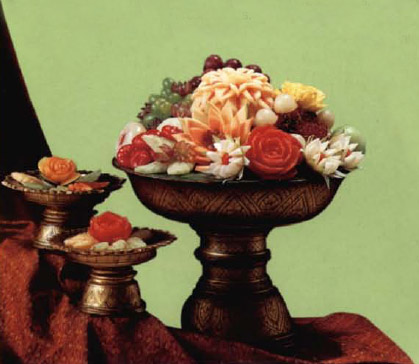
Hours of painstaking effort and great skill are needed to produce the exquisite fruit and vegetable carvings which are a hallmark of palace cuisine
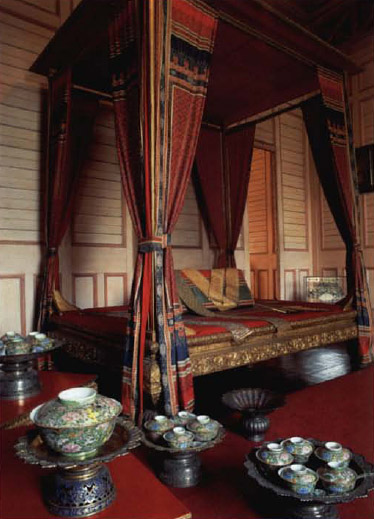
Five-colored porcelain or Bencharong wares seen in the foreground of a corner of Vimarn Mek Palace were originally created in China to meet Thai tastes, but are now produced in Thailand
Fruit and vegetable carving was the most visible of these palace skills. Watermelons, spring onions, mangoes, ginger root and other garnishes and delicacies became intricately carved flowers, leaves, and abstract designs through the deft use of a knife, sometimes taking longer to prepare than the dishes they adorned.
Royal polygamy ended under King Rama VI and the royal women and their attendants gradually left their protected existence and made new lives for themselves outside the palace walls.
Fortunately, Thailand's palace cooking did not vanish along with the hidden world where it originated. It survived through the descendants of the royal women and, especially in recent years, has been discovered by a wider public through several restaurants that take great pride in their re-creations of this uniquely fascinating cuisine.
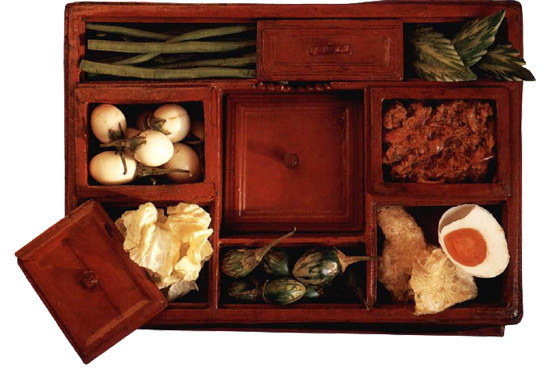
Nam Pok Ong, a spicy pork and tomato dip. surrounded by raw vegetables, sailed duck egg and crispy pork skin.
Instead of the soft, boiled rice of the central region, northerners prefer a steamed glutinous variety, rolled into small balls and dipped into liquid dishes. Curries of the region tend to be thinner, without the coconut milk so widely used in central and southern cooking. There is also a distinctive local version of Nam Prik Ong. a basic dipping sauce served with raw vegetables and crispy pork skin, as well as a pork sausage called Naem, eaten plain with rice or mixed into various dishes. When it is in season, the favorite local fruit is the succulent longan, which grows in almost every compound
Regional Styles and Foreign Influences
The influence of neighboring Burma and Laos is apparent in many northern dishes The former, for example, was responsible for the popular Khao Soi, a curry broth with egg noodles and chicken, pork or beef, as well as Gaeng Hang Lay. a pork curry seasoned with ginger, tamarind and turmeric. Of Laotian origin are Nam Prik Noom, a sauce with a strong chili-lime flavor and Ook Gai, a red chicken curry with lemongrass.
The traditional form of entertainment in the north is the kantoke dinner, the name derived from kan, or "bowl," and toke, a low round table made of woven bamboo, plain or lacquered Sitting on the floor around the table, guests help themselves to the assorted dishes placed on it and regularly replenished by the attentive hostess.
Like the north, northeastern Thailand was also long regarded as remote from the cosmopolitan world of Bangkok. In this case, however, the reason was not so much geography as a perceptible social prejudice on the part of city dwellers. Isan, as Thais call the northeast, was the poorest of the country's four main regions, with infertile soil and devastating droughts that frequently drove farmers to the capital in search of work as laborers, taxi drivers and domestic servants.
Finicky outsiders tended to look on Isan food as "strange," and some of the region's delicacies are certainly unusual when compared with the abundance of other areas: grubworms and grasshoppers, for instance, ant eggs, snail curry and fermented fish of exceptional pungency. But increasingly, other less exotic dishes typical of the region have won widespread admiration, to the point where they now appear on the menus of smart Bangkok restaurants and are savored by the most discriminating Thai food connoisseurs. Some diners, indeed, look upon a properly prepared Som Tam (spicy green papaya salad) or Laab (even spicier minced pork or chicken) as being the true marks of a superior Thai cook, wherever he may be plying his trade.
If the people of Isan "eat anything," as residents of other regions often remark, they have a definite skill for transforming it in ways that show both imagination and ingenuity. Barbecued chicken or Gai Yang, is grilled with a healthy lashing of peppery sauce and garlic, while catfish is the base of a delectable curry, and Laab Dip is made with raw meat and roasted rice powder
For Haw Mok, fish is ground with curry paste and then steamed in banana leaf to make a many-flavored custard. Beef—a relatively rare commodity—is marinated and grilled, and any leftovers are combined with fresh mint, green onions and chilies for a fiery salad Perhaps because chilies add such a zip to the most mundane dish, northeasterners tend to use them with a greater abandon than Thais of other areas.
Much northeastern cooking reflects the influence of Laos just across the Mekong River—not surprisingly since many residents are ethnically Lao. Dill (called pak chee Lao or "Laotian coriander" by Thais) is widely used as a garnish, and glutinous rice is preferred to the normal variety. Also of Lao origin and popular on festive occasions is Khanom Buang, a crispy crepe stuffed with dried shrimp, bean sprouts, and other ingredients.
Southern Thailand consists of a slender peninsula stretching down to Malaysia, dramatically different from the rest of the country in both scenery and culture. Lush jungle clambers up craggy limestone mountains, nurtured by rain that falls for eight months of the year, and cultivated areas tend to be vast rubber and coconut plantations rather than the familiar rice fields and fruit orchards of the central plains. From villages along two long coastlines—one on the Gulf of Thailand, the other on the Indian Ocean—thousands of boats sail out to fish the surrounding waters, bringing back seafood for local consumption and profitable export.
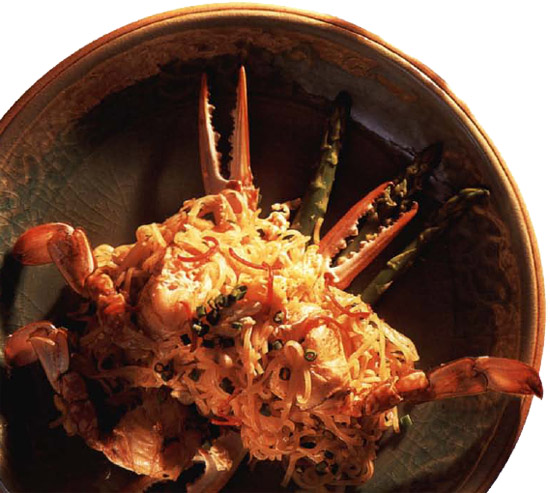
Fried noodles with crab claws
Highly distinctive visually is the domed mosque, for the south is home to most of Thailand's two million Muslims, its largest religious minority. These are concentrated in the provinces adjacent to Malaysia, where Malay is spoken as commonly as Thai. In other southern places like Songkhla and the island of Phuket, Chinese predominate and lend their own particular color to the local scene.
Southern food reflects most of these features, cultural and otherwise, as well as others from its more distant past when traders from India and Sumatra sailed to its numerous ports. The graceful coconuts to be seen growing so plentifully everywhere provide milk for thickening soups and curries, oil for frying, and grated flesh as a condiment for many dishes
From the seas come huge marine fish, rock lobsters, crabs, mussels, squid, prawns and scallops, while local plantations yield cashew nuts, which turn up regularly as an appetizer or garnish, and small but juicy pineapples, which provide a popular sweet at the end of a meal.
Seafood may be prepared simply, grilled or steamed; or more elaborately, baked in a claypot with thin noodles and garlic; or as the main component of Tom Yam, that ubiquitous Thai soup laced with lemongrass and chilies. In general, southerners like their food chili-hot, and are fond of a bitter taste imparted by a flat, native bean called sa-taw, which other Thais tend to find less appealing.
Contributions from other cultures include Gaeng Mussaman, an Indian-style curry with cardamom, cloves, cinnamon and either chicken or beef; Malay fish curries, often with a garnish of tamarind and fresh fruit; and Indonesian satay, marinated bits of meat on bamboo skewers with a spicy peanut sauce.
The fourth of the country's regions, the Central Plains, is the Thai heartland: a vast checkerboard of paddy fields, orchards and vegetable gardens, with Bangkok as the principal market and cultural magnet. The best rice comes from here, pearly white and fragrant, and so do the best fruits—mangoes and durians, ruby-red mangosteens and hairy rambutans, crisp guavas, papayas and pomelos, even grapes in a special tropical hybrid. Vegetables, eaten in large quantities, include cabbage, mushrooms, morning glory (water spinach), cucumber, tomatoes and pumpkins, as well as more recent introductions like asparagus and baby corn.
Food in the villages that stand like islands amid the fields tends to be plain: rice with stir-fried vegetables, fish from a nearby canal or river, perhaps some minced chicken with garlic, chilies and basil and a salad of salted eggs, chilies and spring onion with a squeeze of lime.
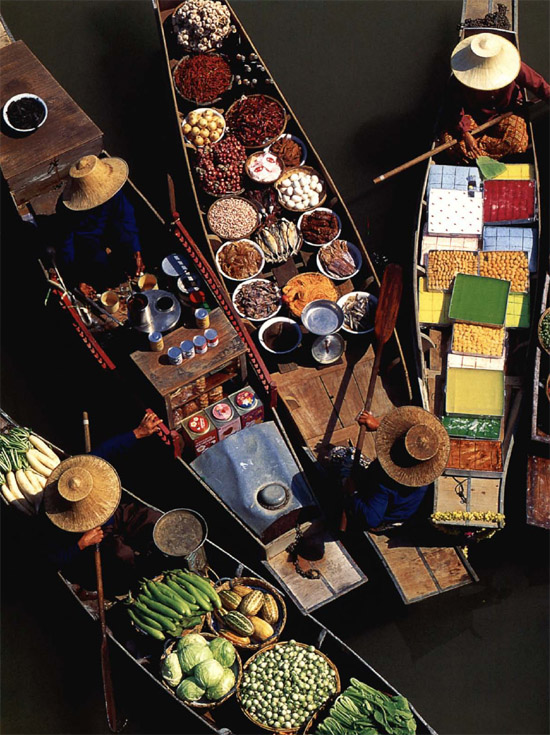
Floating markets, where everything you might need is piled onto a boat and paddled along rivers and canals